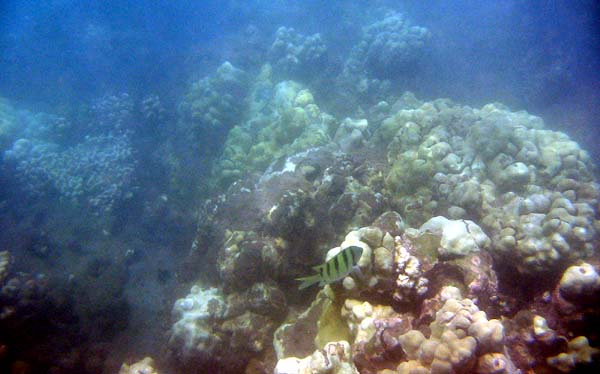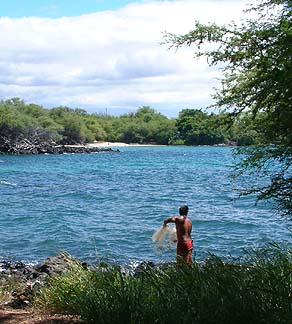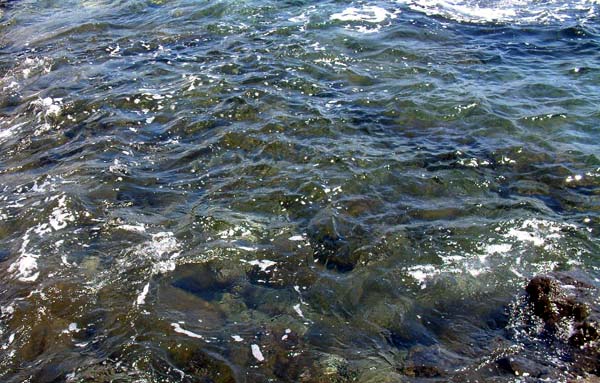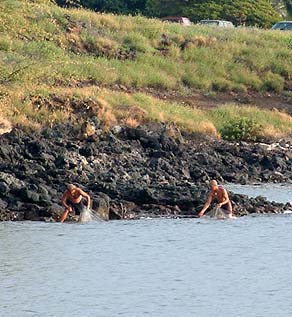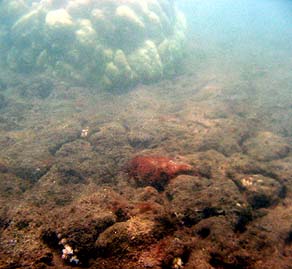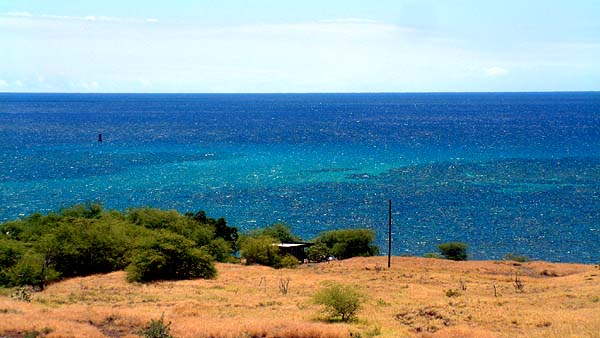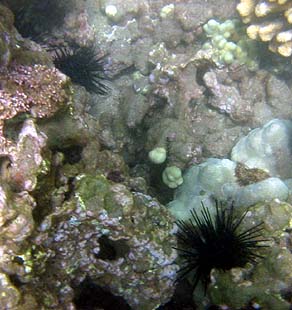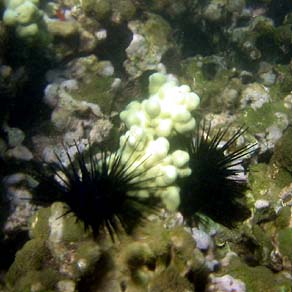 |
 |
 |
|||||
|
|
|||||||
| |
|
|
|
The fringing reef off Spencer Beach.
|
"We catch reef fish mostly," Papa Akau says. "Manini, kohole [kole], maiko [surgeonfish], and all that. But seasonal, everything is in season. You just don’t catch any time. Certain times you go, the Hawaiian say momona, full with fat, so when you cook it, the fat just melts into the meat there and when you eat, it’s really delicious. So you got to follow Mother Nature. Tells you timing. You just don’t take when you want, you see; you take when the time is there. So that’s how we live." "My husband’s brothers all fished off there," Lani says. "Menpache at night, and upupalu, and during the day you catch po‘opa‘a [stocky hawkfish], all kinds of fish. Not rod and reel, just hook and bamboo. Those days, they don’t have rod and reel. But they were good fisherman. My husband never went to the beach and came back with nothing. Never did."
|
||
|
|
||
“There’s what they call imu,” Papa describes, “just like you make imu for kalua pig, with wood, burn it. Well this is a rock pile, just rocks, you sit maybe three rocks and then you put a cap on it so you have that space in between. “That space was for the fish to go inside”, Mel adds. “When the kole are running, you only gotta throw the top, the kole all come out, bring the net. And then go to the next imu. You would make maybe five or seven imu, when you have enough fish for what is needed, you would break all the imu.” “When you see the fish feeding,” Papa says, “and when something moves like that, take it off and get in here. So when you see the fish running through the imu, you just throw a net over and you shake the thing, they kick out, get it in your net, then you take the net, you put the imu back, you wait for tomorrow. Kole is delicious.”
|
|
|
"The old man who taught me fishing," Craig says, "he said he would go from Puako, and he’d stop at every little, special place on the shore line. Like where water would come out and certain algae would grow on those rocks. So what he would do is he’d take those special rocks that he had in the water and he’d make a big old ko‘a, he called it—a house for the fish. So the fish could get the limu that was growing in the cracks that weren’t normally exposed, he’d take the rocks that the fish couldn’t get and he’d turn them upside down. "The kind of limu that those kind of fish eat, it doesn’t grow on that kind of coral. Coral only grows algae. Small, short stuff. The the hard basalt rock, that’s the kind where the limu grows. And the pa‘ala [smooth, dense, water-worn, volcanic rocks], you know the flat one, that’s the one the things used to grow on the crack and the fish couldn’t get in there. So I would take them, turn them upside down and there’d be lettuce limu. That’s what they call them. That’s the one the fish like. You know, anything green in the ocean, they love ‘em."
|
|
|
|
|
“So he made a house for them to come and eat, where they were welcome. And they were happy because they had more food on that pile that he turned over, so the next day when he came back, he knew that that was exactly where the fish would be. Because he had made a trap for them. And he threw his net over there and he got the fish. And then when he got done, he put the rocks back exactly to where they were before he got there. "And that’s what he called ko‘a, building a ko‘a, and he’d do that like a dozen times down the shore line. And every time he’d come back, he’d put the rock exactly back the way he got them. And next time he come, next week, next year, same thing. That’s how the Hawaiians did their own fishing. "He’d throw the net over the ko‘a and then take it apart to take all the fish out. He’d take the net off with the fish all stuck in it, and then put the rocks back the way it was. Put them all back flat, or however they were. Turn them back upside down so the fish can’t get back at the limu anymore. And leave the place, not leave it like that so that somebody else can come. So that’s what his interpretation of the fisherman’s version of the ko‘a was."
|
||
|
|
||
“And then ku‘una is another thing,” Papa says. Ku‘una is a place where a net is let down in the sea. “You like this from the shore line, running out a strip like this. So usually the fish follow, just like a road. Comes in up here, and this is the shore line, comes up here and they start feeding. So you know that’s where they feed, you know where they come up, and where they’re going back. "So what you do, when you see them on the feeding area, you set your net out here. So the moment you drop something here—drop a rock here—they all going to head there and follow that out. So when they follow that out, they go right into your net. That’s what they call ku‘una."
|
|
|
“You got to know the area. You got to know the current, the feeding ground. This is passed on by families who know the area. They tell you, when you see them feeding over there, they’re going to run over here. So you put your net over here. You don’t put your net over there, you see, because they’re going to kick out over here. But if you put your net over here, you’re going to get everything from over there, right into your net. It’s where they run back. They come out from all directions on the feeding area. But when you scare them, you watch, they’re going to run that one way, just like a road. They’re not going to run anywhere. “So just like with us, if the trail is there, you’re going to run on the trail. The fish do the same thing. Maybe they feed over there, but they know the road back out in the deep is that way, so they head that way. You have to know all of this kind of thing for throw net, set net.”
|
|
|
|
|
“I remember when the fishermen would surround net,” Lani says, “and everybody would go there and help them to bring the nets in. And everybody goes would get three fishes like that, three akule. Three akule, each person. I would go with three, my sister was there she would go with three, and my brother would go with three. And that would be our food for the whole week. We did all of that. My mother also dried the akule. “Maybe every other week we’d do that. But these Hawaiians, they’re smart. They know when the fish are coming in. They know when to expect the akule to come in. And they’re going to surround the net and leave it over night. It was a lot of fun doing that."
|
||
|
|
||
“A certain time of the year," Pua recalls, "when the kiawe tree was full of flowers, my Dad would say, ‘If the water is clear today, we’re going to make wana.’ When I hear wana, I come weak, because that’s a lot of work! We go with a big tub, we put it in an inner tube and then we follow him. "And when that tub is full, we got to come ashore, put them all in a grass bag, shake them, shake them, in the sand, then you got to take it out, get all the spines away from it, and put it in a little pool, and then you got to clean it. Oh, and it’s so hot, and you got to stay there with the thing, crack them all, take them all out, and put it in a bowl. But after everything is done, and we go home, that’s going to be our meal now for the night. It’s so good.” “Of course it wasn’t always fat," ‘Ilima explains, “we had to wait for season, and we knew it was season when the hala fruit was nice and yellow. That means it’s wana season. We’d see all the Hawaiians picking wana."
|
|
|
“You find it on the coral reef, and usually where you have coral, especially down at Kawaihae, it’s shallow. I remember holding the tub for my uncle as he dove for wana and getting poked, because the water where the reef is, used to pull. It was hazardous getting the wana. My uncle would go when it was low tide, because then he didn’t have to dive. He would just stand on the reef and just scoop it. "But we needed to be near him with our big pakini [bucket, metal pot] so that he could put it in. And of course the water surged, and we couldn’t put our feet down because we had no goggles, so we couldn’t see where they were, so we’d kind of lift our feet and we get tired and put our feet down and BANG. “He made like a fork, with very heavy wire, and he would get it about two feet long, bend it in half and twist it. And then just at the end he would separate it into a fork and then pick them up, put them in the pakini, and then we would take them to shore and put them in the shaker."
|
“We usually have this basket that’s made from hog wire. And then you’d have handles on both sides. One person stood on either side, and we would shake it until all the thorns came off, and then we’d just get a little rock and sit and just crack where the teeth are, and then take that out and the meat. The body is round and we would just crack the center and pick out all the meat. It’s a delicacy. “The wana that comes from Japan, if I’m not mistaken,
it’s different from the local wana. The local wana
is softer, sweeter and it melts. A lot of Hawaiian people let it melt
because they want to lomi with their ‘opelu.
And if you just want to eat it, then you just can eat it then. You need
to eat it right away, otherwise, instead of having the flesh you’ll
have gravy. Which is O.K., anyway."
|
|
|
|
|
"Wana is really strong tasting, and it’s really rich," ‘Ilima concludes. "A lot of people get diarrhea from it. But not too many people eat wana nowadays. Not the young generation. It’s just the older people. It’s considered a delicacy and it takes a lot of work. You need to dive for it and clean it. Maybe people would give it away, but I don’t think they would ever sell it, because it’s too precious. They would keep it for their families."
|
||
|
|
||
|
|
|
|
|
|

|
| Kawaihae Home | Map Library | Site Map | Hawaiian Islands Home | Pacific Worlds Home |
|
|
|
|
|
|
|||
| Copyright 2006 Pacific Worlds & Associates • Usage Policy • Webmaster |
|||
